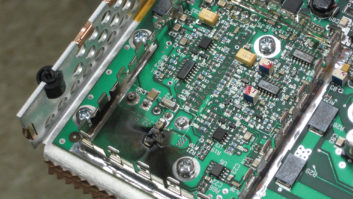Ron Huckeby, CBRE, of Butte, Mont., handles engineering for a number of stations. Ron says there are times when you are in the hinterlands and you just have to use what you have on hand to fix a problem.
Ron had a station whose Harris FM-2.5K transmitter lost its screen capacitors. This happened when one of the voltage balancing resistors on the two 450V computer grade capacitors that were in series opened up.

Fig. 1: Stringing a few capacitors together got the transmitter running.
After diagnosing the problem, Ron found several 2000V capacitors at the AM site, of a few microfarads each. Using “what was available” (shown in Fig. 1), Ron got the station back on the air at full power.
A temporary fix, but it worked.
As for safety, Ron was the only engineer with keys to the site, but the capacitors were covered with a box and a handwritten warning sign. Ron writes that the transmitter has since been replaced with a Nautel NV-5LT, but the FM-2.5K is still in place as a backup and was properly repaired. That’s the key — make a point to not leave temporary repairs as a permanent solution!
Ron also included a photo taken by Greg Muir, principal engineer of Wolfram Engineering and a frequent Workbench contributor.

Fig. 2: Another temporary capacitor fix returns a transmitter to air.
Fig. 2 shows a similar “fix” inside a transmitter. In this case, the phase loss relay in a Harris HT-25 was acting up, causing the blower circuit breaker to trip.
The site was over an hour from Greg’s home and had to be accessed by an off-road utility vehicle on tracks. In this case, Greg found a high-voltage capacitor from a retired tower strobe light system, and was able to get the relay back in service. As the site is single-phase and the transmitter uses a Roto-phaser, bypassing the relay was not an option.
Although neatly implemented, Ron points out, this was just a temporary repair in order to get the station back on the air.
Temporary fixes are supposed to be just that, but do you have some that have become permanent? We’ve all done it. Make a resolution for 2018 to repair such issues correctly and permanently.
***
This past summer, a thunderstorm barreled through Hamden, Conn. A lightning strike got Bob Meister’s attention. The strike induced some rather high voltages to the power grid and transmitter site. One of the surge protectors on the 4,800V AC line to the building’s step-down transformer shorted, taking out a fuse on the street. It also charred the wiring on the primary side of the transformer.

Fig. 3: Bulging electrolytics due to lightning.

Fig. 4: The lightning also vaporized traces on the control board.
The surge also made its way to the sliding gate controller board, either by traveling along the chain-link fence, or via induction through the underground power line. The 24VAC power transformer output apparently exceeded that voltage by quite a bit, as it blew several electrolytic capacitors, seen in Fig. 3, and completely vaporized foil traces on both sides of the circuit board, shown in Fig. 4.
Bob writes that this is fourth time in about 17 years that the gate controller has had to be repaired or replaced. There’s a wireless remote control attached to the transformer that has also suffered shorted power supply diodes and vaporized traces over the years.
What’s curious is that nothing else at the facility sees to suffer ill effects from storms, except one instance when a storm caused an Astron RS35M power supply tripped its over-voltage crowbar, and needed to have its power cycled to reset it. Those are the simple kind of post-storm issues engineers like!
If you are troubleshooting defective equipment after a storm or power surge, look especially for the vaporized traces, or the distended or blown out tops of radial electrolytic capacitors shown in the image, or bulging ends of axial-mounted electrolytic capacitors. The bulge is a sign of an unhappy cap — replace it! As for the vaporized traces, I’ve seen some repairs where the engineer has used short pieces of insulated buss wire or fine wire wrap wire to replace the traces. The repairs may or may not work, but it’s probably worth a try.
Got high-resolution pictures of similar repairs you’ve made? Email them to me and share your experiences with fellow Workbench readers. Send them to [email protected].
***
Hubbard St. Louis Chief Engineer Bob Hoffman, CPBE, read the Workbench submission by Dan Slentz, “Your 2018 Resolution: Document Everything,” referring to Visio and Draw.
Bob writes that he has used NCH Software’s “Clickchart Diagram Flowchart Software” for simple schematics. It’s easy to use and lets you save your diagrams in PDF form.
You can find out more at www.nchsoftware.com/software/index.html.
Your ideas, submitted for Workbench, can help fellow engineers and qualify for SBE recertification credit. Send tips and high-resolution photos to [email protected]. Fax to (603) 472-4944.
Author John Bisset has spent 48 years in the broadcasting industry and is still learning. He handles Western US Radio Sales for the Telos Alliance. He is SBE certified and is a past recipient of the SBE’s Educator of the Year Award.











